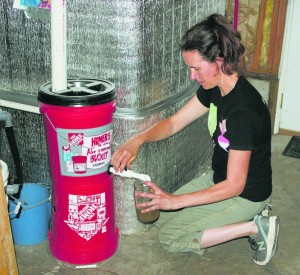From Food Waste to Nutritious Compost for Growing Fresh Veggies, the System Completes the Circle
By Kathy and Edward Puffer
What’s in your basement? Furnace, shelves, boxes of stuff you forgot you had?
We are the Puffers in Tillson, New York, and we have all of that too. But we have one more thing. In one corner of the basement, where we never got around to putting in a kitchen and bathroom setup, we have something even more interesting.
It looks like an insulated box with pipes and tubes stuck into it, and it bubbles and belches as if it came from the mind of a mad scientist. In one end, we put our food scraps. Out of the other end, we get excellent, organic liquid compost. And out the top, we get enough methane gas to cook just about all of our meals.
Say hello to the world’s first indoor residential twin bio-digesters, in the Hudson Valley of NY.
Anyone who gardens knows it is important to keep a compost pile for vegetables and garden waste. The form of composting usually done in a compost bin is aerobic, meaning “with air.” It is actually less effective than an anaerobic system that is essentially a big plastic stomach with the air sealed out. In an anaerobic digester, the microbes are able to produce even-more-nutritious compost. And it also gets you cooking with gas.
The first seeds of our basement project were sewn in 2013, when we met Professor Thomas Culhane of Mercy College. He is a champion of biogas as an alternative to the wasteful and polluting fossil fuels that the world has come to depend on, and he saw our basement as the ideal place to bring his concept to life (yeah, he’s the mad scientist in this story, but he’s mostly harmless). His first installation is at his home in Germany, where it works very well, but it is outdoors and therefore freezes solid during the winter.
In the spring of 2014, Professor Culhane brought a team of students to Tillson to set up our system. Two IBC tanks sit in the basement, full of horse manure. An Insinkerator food grinder sits beneath the kitchen sink to break up all food waste we put into it. The plumbing is re-routed so that, whenever we want, everything that goes down the kitchen sink will flow into one or both bio-digesters. A Raspberry Pi [a type of single-board computer the size of a credit card] is installed to record the temperatures inside the tanks (top and bottom) and outside.
With constant in-tank temperatures around 90ºF, and a good feeding every day or so, the active microbes from the horse manure eat the food waste and burp out about 500 liters of methane gas every day. The gas flows through tubes and outdoors to a heavy-duty plastic bag made by EDPM. For cooking, there is more tubing that brings the gas to a Shenzen Puxin Technology GB/T3606-2001 two-burner gas stove in the kitchen.
That’s just the gassy benefit. The solid matter that goes in and is eaten then becomes a highly-nutritious liquid compost. This is known as bio-slurry, although some of us with a nose for fine wine like to call it Compeaujolais. It is the newest, freshest, most potent form of compost available anywhere.
The bio-slurry is fed to several “aeroponic” vertical gardens that produce basil, lettuce, tomato, parsley, beans, spinach, Swiss chard, and bok choy. Vertical aeroponic farming [sometimes called a type of hydroponic farming], like these made by AERO, Rethinking Growth, need only 5% of the water used in conventional farming.
Kathy runs comparison tests by growing vegetables using standard hydroponic nutrients, and she is seeking spectrographic analysis on why her bio-slurry results are spectacularly better. She sells aeroponic vegetables at a farmers market that is part of local Creative Commons (which uses a local currency called the “Current”). She is working with local officials to include household anaerobic digestion in building codes.
We also have an outdoor bio-digester that produces about 500 liters of gas per week. Gas from this unit is used on a grill for barbecues. Feedstock includes plant waste and chicken manure.
Kathy is a founding board member of Solar C3ities, Professor Thomas Culhane’s organization. Solar C3ities has a demo in Westchester County at Yosemite Park that was facilitated by Paul Feiner. Children will use the anaerobic digester for disposing of food scraps. Gas will be used to grill on a gas barbecue.












Marvelous, the future is here. I like to build one. Please send me info on where I can get one.
Dear Kathy,
Thanks for the informative writeup. It is motivating to see how biogas can be produced with household food waste & other organic matter. Please let me know whether the microbes are like consumables that have to be procured regularly? How frequently we should do maintenance of the system.
The microbes are a one time inoculation of horse manure. They reproduce indefinitely as long as they are fed. It’s equal-in-equal out. Learn more about how a biodigester works from our TedTalk. https://www.youtube.com/watch?v=zNDPDBmBPzU
As of today, we have had our basement biodigester for two years. No need for maintenance so far, we keep feeding our digesters and they keep producing compost tea and biogas to cook our food.